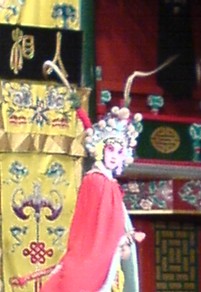Beijing, August/September 2005
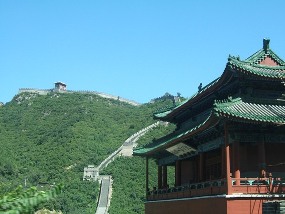
Throughout this page there are photos that I took while I was there. Also, check out the China photo pages to see more famous sights in China that Clare and I visited during the extra 2 weeks we spent there!
- What's in a name? ~ the meaning of Beijing
- Ancient Beijing
- Modern Beijing
- Beijing Culture
China photo pages - Sightseeing pictures from Guangzhou (a.k.a Canton), Guilin, Xi'an (Terracotta Warriors), Shanghai and Hong Kong.
Most of the facts used in this article were taken from Wikipedia.
What's in a name? ~ the meaning of Beijing
Beijing literally means "northern capital", the result of an East Asian tradition to name capital cities as such: other cities similarly named include Nanjing meaning "southern capital", Tokyo and Tonkin (now called Hanoi, the capital of Vietnam) both meaning "eastern capital", Kyoto and Gyeongseong (The capital and largest city of South Korea) both meaning simply "capital".
An older English name for Beijing is Peking. The term originated with French missionaries four hundred years ago, and corresponds to an older, now obsolete pronunciation which predates a subsequent sound change in Mandarin.
Between 1928 and 1949, it was known as Peiping (Beiping) which means "Northern Peace". The name was changed - with the removal of the element meaning "capital" (jing or king) - to reflect the fact that, with the Kuomintang government having established its capital in Nanking (Nanjing), Peking was no longer the capital of China, and that the warlord government based in Peking was not legitimate.
The Communist Party of China reverted the name to Beijing (Peking) in 1949 again in part to emphasize that Beijing had returned to its role as China's capital. The government of the Republic of China on Taiwan has never formally recognized the name change, and during the 1950s and 1960s it was common for Beijing to be called Peiping on Taiwan to imply the illegitimacy of the PRC. Today, almost all of Taiwan, including the ROC government, uses Beijing, some maps of China from Taiwan still use the old name along with pre-1949 political boundaries.
back to top
Ancient Beijing
Beijing is a world-famous city for its long history and splendid culture. According to archaeological discoveries, more than seven hundred thousand years ago, there were primitive people (Beijing Ren) in this area. Some 600,000 years ago, Peking Man, man's forefathers lived at Zhoukoudian, 48 kilometers southwest of Beijing. The written records show that in 350 BC, it was occupied and made the capital of Ji. Later in its history it got other names such as Zhuojun during the Sui Dynasty (581-618), Youzhou during the Tang Dynasty (618-907), Nanjing and Yanjing during the Five Dynasties and the Liao Dynasty (907-1125), Zhongdu during the Jin Period (1115-1234), Dadu during the Yuan Dynasty (1271-1368), Beiping and Beijing during the Ming Dynasty (1368-1644), Beijing during the Qing Dynasty (1644-1911), Beiping again under the control of Nationalist Party (1912-1949) and it finally was named Beijing after the People's Republic of China was founded in 1949. In the year 1272, Beijing became the Capital of a unified country for the first time in the Yuan Dynasty (1206-1368), which was written in the Travels of Marco Polo.
Today Beijing is the center of national politics, economics, culture, transportation and tourism.
back to top
The Forbidden City
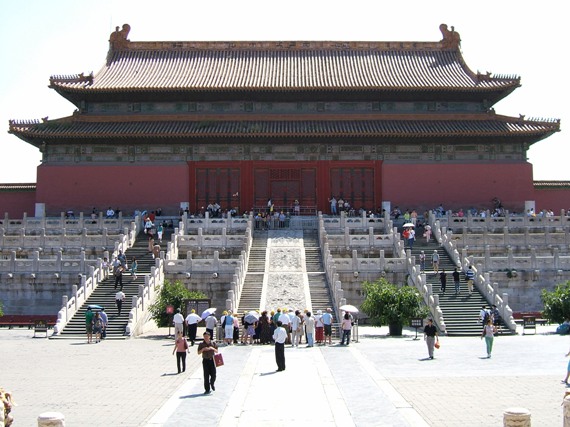
The Hall of Supreme Harmony, at the center of the Forbidden City
The Forbidden City was constructed (1406-1420), followed by the Temple of Heaven (1420), and numerous other construction projects. Tian'anmen, which has become a state symbol of the People's Republic of China and is featured on its emblem, was burned down twice during the Ming Dynasty and the final reconstruction was carried out in 1651.
The Forbidden City or Forbidden Palace was constructed from 1406-1420, and is located at the exact center of the ancient city of Beijing. It was the imperial palace during the mid-Ming and the Qing dynasties. Known now as the Palace Museum , its extensive grounds cover 720,000 square meters, 800 buildings and 9,999 rooms. As such, it is listed by UNESCO as the largest collection of preserved ancient wooden structures in the world, and was declared a World Heritage Site in 1987 as the "Imperial Palace of the Ming and Qing Dynasties". The imperial palace grounds are located directly to the north of Tiananmen Square and are accessible from the square via Tiananmen Gate. Tian'anmen, which has become a state symbol of the People's Republic of China and is featured on its emblem, was burned down twice during the Ming Dynasty and the final reconstruction was carried out in 1651.
We visited the vast Forbidden City and were amazed by the sheer scale of it! It was undergoing a lot of renovation while we were there, in preparation for the Beijing Olympics in 2008.
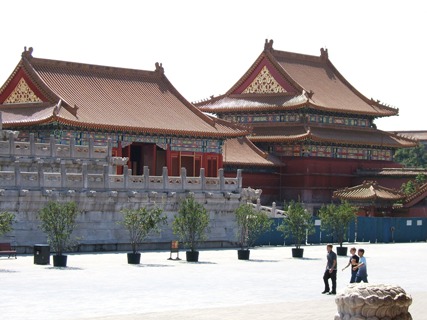
Palaces in the Forbidden City
back to top
Temple of Heaven
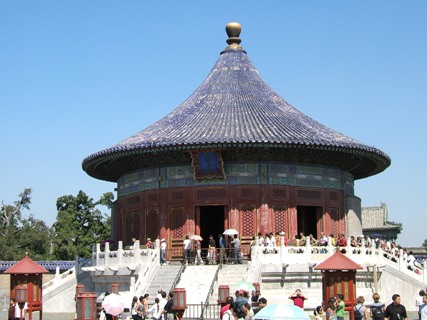
The Imperial Vault of Heaven at The Temple of Heaven
In ancient China, the emperor was regarded as the "Son of Heaven", who administered earthly matters on behalf of, and representing, heavenly authority. To be seen to be showing respect to the source of his authority, in the form of sacrifices to heaven, was extremely important. The temple was built for these ceremonies, mostly comprised of prayers for good harvests.
Each winter solstice the emperor and all his retinue would move through the city to encamp within the complex, wearing special robes and abstaining from eating meat; there the Emperor would personally pray to Heaven for good harvests. The ceremony had to be perfectly completed; it was widely held that the smallest of mistakes would constitute a bad omen for the whole nation in the coming year.
Surrounding the Imperial vault (shown above) is the famous Echo Wall. Supposedly if two people stand facing the wall on opposite sides of the courtyard and speak towards the wall, their voice will be heard by the other person. While we were there lots of tourists were trying this for themselves, often shouting so loudly that they could be heard echo or not!
back to top
The Summer Palace
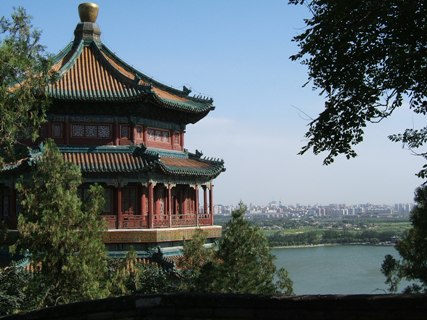
Cloud Dispelling Hall at the summit of Longevity Hill (in the distance Kunming Lake and the Beijing skyline)
The Summer Palace or Yiheyuan is mainly dominated by Longevity Hill (60 meters high) and the Kunming Lake. It covers an expanse of 2.9 square kilometers -- three quarters of which is water. In its compact 70,000 square metres of building space, one finds a variety of palaces, gardens, and other ancient-style architectural structures.
The Summer Palace started out life as the Garden of Clear Ripples in 1750 in the reign of Emperor Qianlong. Artisans reproduced the garden architecture styles of various palaces in China. Kunming Lake was created by extending an existing water body to imitate the West Lake in Hangzhou. Suffering two attacks -- an Anglo-French allied invasion in 1860 (with the Old Summer Palace also ransacked at the same time) and the eight-power allied forces in 1900 -- it survived and was recreated in 1886 and 1902. In 1888, it was renamed to become the current-day Yihe Yuan, serving as a summer resort for Empress Dowager Cixi, who diverted 30 million taels of silver, said to be originally designated for the Chinese navy, into the reconstruction and enlargement of the Summer Palace.
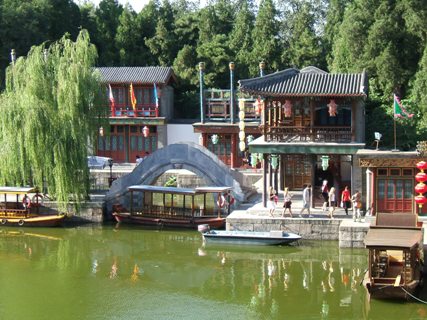
Suzhou Street - A reconstructed ancient village in the Summer Palace grounds
Within the grounds of the Summer Palace, along the Back Lake, lies Suzhou Street. The street design imitates the ancient style of shops on the banks of rivers in Suzhou City, Zhejiang Province, that is, taking the running water of Back Lake as the street and its banks as a market. The area served as an entertainment place where Emperors and concubines could feel as if they were strolling on a commercial street. When the royals went there, eunuchs and maids of honor would playact as peddlers, customers and shop assistants to mimic market activities. Today's market includes stores such as dyers, souvenir shops, drugstores, banks, shoe stores, teashops, and hockshops, with clerks dressed in Qing Dynasty (1644-1911) costumes. It was really charming, but tourists have to be careful, there are no handrails and often only a couple of feet of pathway to navigate around the inlet. We didn't see anyone fall into the water, but I bet it happens!
back to top
The Great Wall
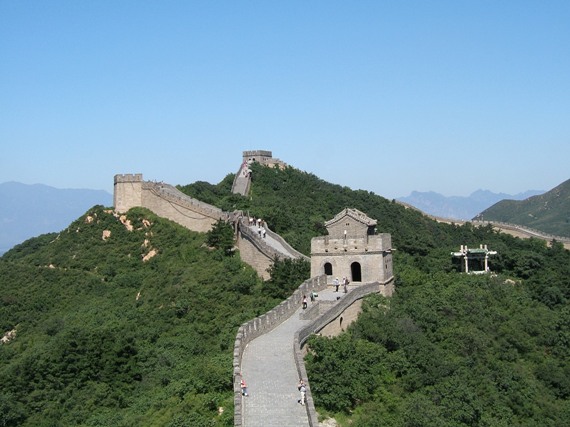
The Great Wall at Badaling, just outside Beijing
No trip to China would be complete without seeing the Great Wall! We went there as part of an organized trip the day after the conference finished. The heat was incredible, and climbing it is no mean feat! The wall is so steep in places that it is a treacherous climb, and a terrible place to slip! The intrepid are rewarded with incredible views, as far as the mountains of Mongolia There is also the added bonus of trying to run the gauntlet between the hundreds or sellers just waiting to pounce on tourists and sell them hats, t-shirts, Chariman Mao watches and a whole host of other interesting paraphernalia.
Badaling is the site of the most visited section of the Great Wall of China, approximately 50 miles northwest of Beijing city within the Beijing municipality. The portion of the wall running through the site was built during the Ming Dynasty, along with a military outpost reflecting the location's strategic importance. The portion of the wall at Badaling has undergone heavy restoration, and in 1957 it was the first section of the wall to open to tourists. Now visited annually by millions, the immediate area has seen significant development, including hotels, restaurants, and a cable car.
back to top
Modern Beijing
Beijing has a population of 10.855 million and is undergoing big changes and heading for modernization as ancient civilization meets with modern achievements. Beijing is the second-largest city in China in terms of population size, second only to Shanghai (which is located in the east on the Pacific and is one of the largest ports in the world).
Tian'anmen Square, located in the city center, is a symbol of both Beijing and China. The solemn flag-raising ceremony has become a sacred daily celebration. Standing in the world's largest city square and looking far east and west up and down the Chang'an Avenue, one can see a centuries-old architectural complex standing side by side with newly-built modern-style buildings, torrent of bicycles flooding by and awareness that Beijing is a mix of modem and ancient.
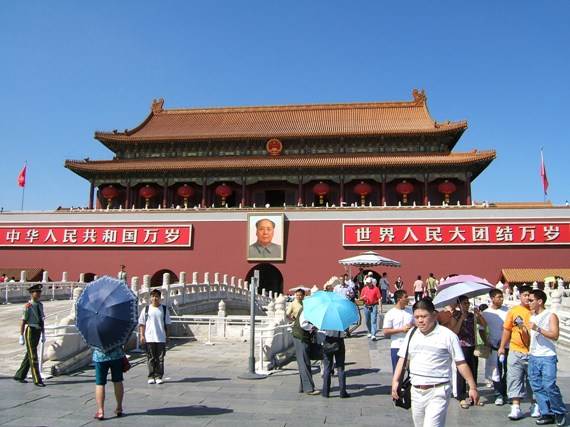
Tian'namen Gate
In the sweltering heat it seemed strange to see so many umbrellas, but it's a common site in China where they use them as sunshades. As natives of rain drenched Scotland we were most amused by this, I can guarantee I have never seen one used back home to keep the sun off! Also ironically this was one of the few trips I have taken where I didn't pack an umbrella!
back to top
Beijing Culture
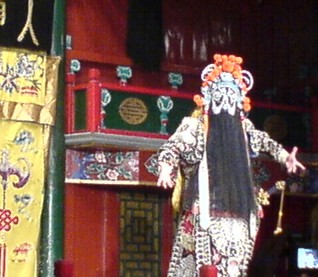
Beijing Opera
Beijing opera, or Jingju, is well-known throughout the national capital. Commonly lauded as one of the highest achievements of Chinese culture, Beijing opera is performed through a combination of singing, spoken dialogue, and codified action sequences, such as gestures, walking, fighting and acrobatics. Much of Beijing opera is carried out in an archaic stage dialect quite different from modern Standard Mandarin and from the Beijing dialect (The dialect of Chinese spoken in Beijing and adopted as the official language for all of China) this makes the dialogue somewhat hard to understand, and the problem is compounded if one is not familiar with Chinese, although modern theaters often have electronic titles in Chinese and English.
The Conference organizers arranged a trip to the opera and it was really quite an experience. Love it or hate it, no-one leaves the Beijing Opera without a strong opinion about it! Personally I thought it was great, and would have liked to see a full length version. Most Beijing Opera on offer is shortened tourist-friendly versions of operas that could last 5 hours or more.
We were also treated to a trip to see the incredible Chinese Acrobats. Never before have I seen such gravity defying stunts! In the picture below there are three men upside down at the very top, supporting the three men below them using straps around their necks and spinning the hanging men at the same time (at great speed!), while at the bottom two men hold their bodies at impossible angles using only their ridiculously strong arms. At times it was impossible to know where to look, because so many incredible things were happening at once! If you are ever in Beijing it is a show not to be missed.
back to top
Just for fun
A little peek into the lighter side of life within the Heriot-Watt Waves & Fields group.
Word of the Week:
Gallivanting
Or:
